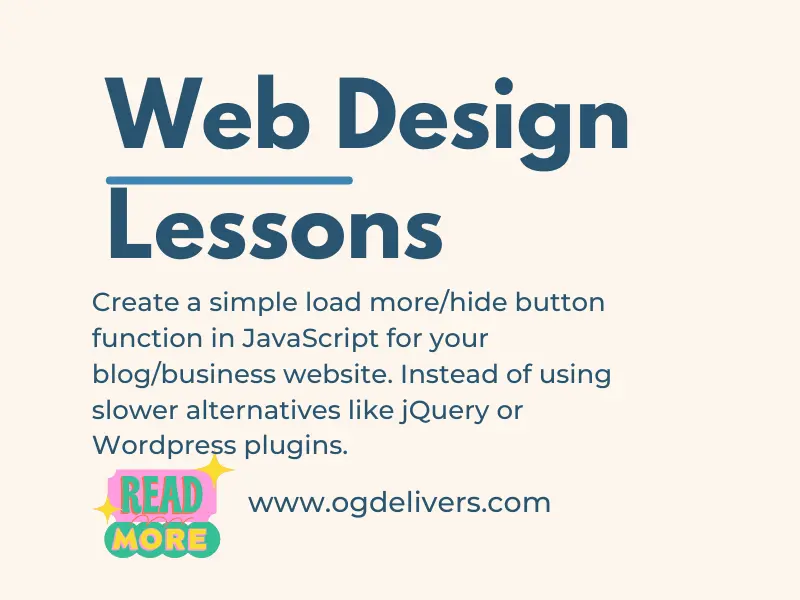
Try it out by clicking load more button
Welcome to this lesson on creating simple JavaScript load more/hide button functions! In this tutorial, we'll walk you through a step-by-step explanation of the provided code, how it works, and how you can customize it to enhance user experience on your website. We'll also discuss the benefits of using simple JavaScript code over alternatives like jQuery or WordPress plugins.
Understanding the Code
Let's start by analyzing the provided JavaScript code:
// Get the "load more" button and all posts
const loadMoreButton = document.getElementById('loadMoreButton');
const posts = document.querySelectorAll('.post-list');
// Initialize a variable to keep track of the state
let isExpanded = localStorage.getItem('isExpanded') === 'true';
// Update the UI based on the stored state
function updateUI() {
if (isExpanded) {
posts.forEach(post => {
post.style.display = 'block';
});
loadMoreButton.textContent = 'Hide';
} else {
posts.forEach((post, index) => {
post.style.display = index === 0 ? 'block' : 'none';
});
loadMoreButton.textContent = 'Load More';
}
}
// Initial UI setup
updateUI();
// Add a click event listener to the "load more" button
loadMoreButton.addEventListener('click', () => {
// Toggle the state
isExpanded = !isExpanded;
// Store the state in local storage
localStorage.setItem('isExpanded', isExpanded);
// Update the UI
updateUI();
});
How the code works
- Getting Elements: The code starts by getting references to the
"load more" button and all posts on the page. The button is fetched using
document.getElementById('loadMoreButton'), and the posts are selected usingdocument.querySelectorAll('.post-list'). - Initializing State: The variable
isExpandedis used to keep track of the current state (expanded or not). It's initialized based on whether a value of'true'is stored in the local storage. This allows the user's preference to be remembered across page visits. updateUI()Function: This function updates the user interface based on the current state. IfisExpandedistrue, it displays all posts and changes the button text to "Hide". IfisExpandedisfalse, it displays only the first post and changes the button text to "Load More".- Initial UI Setup: The
updateUI()function is called initially to set up the UI based on the stored state. - Event Listener: A click event listener is added to the "load more" button. When the button is clicked, the state is toggled, and the UI is updated accordingly. The new state is stored in local storage to remember the user's choice.
Customization and Benefits
Now that you understand the code, let's discuss how you can customize and the benefits of using this simple JavaScript approach:
- Customization: You can customize this code by changing class
names and IDs to match your HTML structure. For instance, replace
'loadMoreButton'and'post-list'with the appropriate IDs and class names from your HTML. - Benefits of Simple JavaScript: This approach offers several
benefits over using jQuery or plugins:
- Lightweight: Simple JavaScript code results in a smaller file size, leading to faster loading times.
- Native Browser Support: JavaScript is supported by all modern browsers, ensuring compatibility without additional dependencies.
- Customization: You have full control over the code and can tailor it to your specific needs.
- Learning Experience: Building functionalities with vanilla JavaScript improves your understanding of core concepts.
By following this tutorial, you've learned how to create a simple load more/hide button using JavaScript. You can easily adapt and integrate this functionality into your website, enhancing user interaction and engagement.
Remember, JavaScript is a powerful tool that empowers you to create dynamic and interactive web experiences. Keep exploring and experimenting with it to unlock its full potential!
Ready to dive deeper into the world of IT careers? Discover more insights, strategies, and tips in our comprehensive guide: 'Looking for a Career in IT?' This extensive resource covers a wide range of topics, providing you with an understanding of the IT industry and its various facets. Whether you're just starting out or seeking to advance your IT career, our guide offers valuable information to help you navigate the path to success.
Building Bridges, Breaking Barriers: The Power of Communication Skills in IT
Communication SkillsMastering Time, Unleashing Productivity: The Key to Success in IT
Master Time Management

